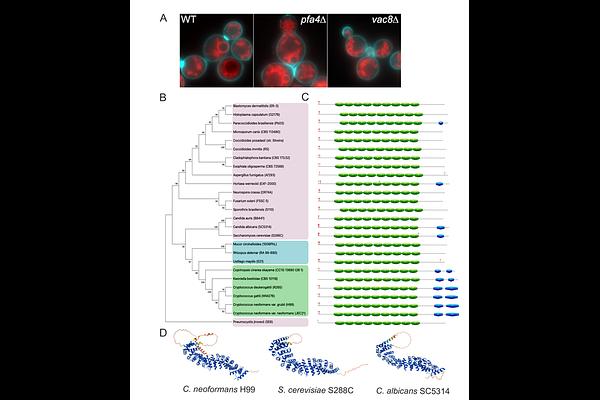The vacuolar protein 8 (Vac8) homolog in Cryptococcus neoformans plays conserved and unique roles in vacuolar and cellular morphology, impacting important stress responses and virulence traits

The vacuolar protein 8 (Vac8) homolog in Cryptococcus neoformans plays conserved and unique roles in vacuolar and cellular morphology, impacting important stress responses and virulence traits
Stuckey, P. V.; Marine, J.; Figueras, M.; Collins, A.; Santiago-Tirado, F. H.
AbstractFunctionally similar to a plant vacuole or a mammalian lysosome, the fungal vacuole plays a vital role in many cellular processes. Most studies of the vacuole have been performed in the nonpathogenic yeast Saccharomyces cerevisiae; however, recently in pathogenic fungi, the vacuole has been implicated in host invasion in both plants and mammals highlighting an important role for the vacuole in pathogenesis. Here, we report that deletion of Cryptococcus neoformans vacuolar protein 8 (VAC8) results in a fragmented vacuole morphology, impairment of vacuolar fusion, and inability to form titan cells. Additionally, absence of Vac8 results in defective growth at high temperature and in the presence of caffeine, suggesting a defect in cell wall signaling. Interestingly, despite aberrant vacuole morphology, vac8{Delta} is slightly more resistant to fluconazole treatment, and displays increased resistance to hydrogen peroxide, suggesting the irregular vacuole morphology does not impair vacuole function. Like S. cerevisiae Vac8, C. neoformans Vac8 is comprised of armadillo repeat regions which form alpha helices that fold to form a superhelix allowing for increased protein-protein interaction. Many of the known binding partners of S. cerevisiae Vac8 are not present in the C. neoformans genome, suggesting novel functions for Vac8 in this fungus. Notably, deletion of VAC8 affected some virulence traits, providing support to targeting the fungal vacuole as a potential therapeutic intervention.